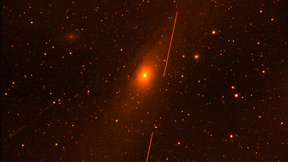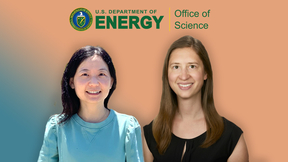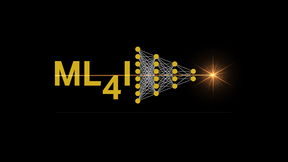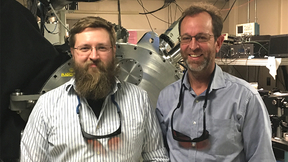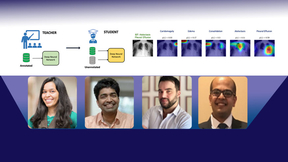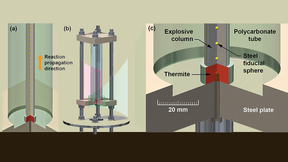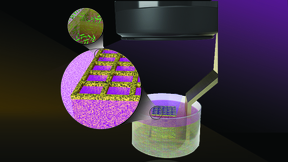Back
Thousands of images of Earth and space have been taken by a compact space imaging payload developed by Lawrence Livermore National Laboratory (LLNL) researchers and its collaborator Tyvak Nano-Satellite Systems. Known as GEOStare2, the payload has two space telescopes that together have taken more than 4,500 pictures for space domain awareness, astronomy and Earth…
Lawrence Livermore National Laboratory (LLNL) joins in the celebration of the U.S. Army birthday on June 14. Created in 1775, the army originally consisted of volunteer soldiers with roots to the Continental Army — and was formed to fight the Revolutionary War. Today, as the largest branch of the country’s military, the proud men and women of the U.S. Army continue to…
A long-held goal by chemists across many industries, including energy, pharmaceuticals, energetics, food additives and organic semiconductors, is to imagine the chemical structure of a new molecule and be able to predict how it will function for a desired application. In practice, this vision is difficult, often requiring extensive laboratory work to synthesize, isolate,…
Two scientists from Lawrence Livermore National Laboratory (LLNL) are recipients of the 2021 Department of Energy’s (DOE) Office of Science Early Career Research Program award. Andrea Schmidt and Xue Zheng are among 83 scientists nationwide selected for the recognition. Under the program, typical awards for DOE national laboratory staff are $500,000 per year for five years…
To address inefficiencies in transmitting electricity over smart grids, engineers at Lawrence Livermore National Laboratory (LLNL) and their collaborators have developed a light-activated switch that, if fully deployed, could reduce carbon emissions by more than 10 percent. Capable of sending high-voltage, direct-current power along grid lines and switching high voltages…
Thin-film electrodes developed at Lawrence Livermore National Laboratory (LLNL) have been used in human patients at the University of California, San Francisco (UCSF), generating never-before-seen recordings of brain activity in the hippocampus, a region responsible for memory and other cognitive functions. In a study published today in the journal Nature Communications,…
The 2021 Conference on Computer Vision and Pattern Recognition, the premier conference of its kind, will feature two papers co-authored by a Lawrence Livermore National Laboratory (LLNL) researcher targeted at improving the understanding of robust machine learning models. Both papers include contributions from LLNL computer scientist Bhavya Kailkhura and examine the…
The COVID-19 pandemic didn’t prevent local high school students from learning what it’s like to be one of the more than 150 machinists who work at Lawrence Livermore National Laboratory (LLNL) during the Materials Engineering Division’s (MED) Manufacturing Workshop, held April 20-22. Students attended the three-day workshop virtually after their school days ended, where…
Ten scientists from Lawrence Livermore National Laboratory (LLNL) last week took part in the 7th IAA Planetary Defense Conference (PDC), hosted by the United Nations Office for Outer Space Affairs in cooperation with the European Space Agency. Megan Bruck Syal, who helped lead the Lab’s participation in the event and who also was a conference session chair, said this year…
Lawrence Livermore National Laboratory (LLNL) is looking for participants and attendees from industry, research institutions and academia for the first-ever Machine Learning for Industry Forum (ML4I), a three-day virtual event starting Aug. 10. Pre-registrations are open for the forum, which aims to foster and illustrate the adoption of machine learning methods for…
Researchers from Lawrence Livermore National Laboratory (LLNL) and their colleagues who help them commercialize technologies have won three national technology transfer awards this year. The trio of awards, from the Federal Laboratory Consortium (FLC), represent the most national awards that LLNL has ever won in one year’s competition over the past 36 years. Two of the…
Lawrence Livermore National Laboratory (LLNL) scientists recently published the results of a three-week experimental campaign at the Lab’s Jupiter Laser Facility to test the performance of laser-heated additive manufactured foams. The project helps support two major Laboratory focus areas, including helping to advance additive manufacturing and by enabling improvements in…
Lawrence Livermore National Laboratory (LLNL) scientists recently published the results of a three-week experimental campaign at the Lab’s Jupiter Laser Facility to test the performance of laser-heated additive manufactured foams. The project helps support two major Laboratory focus areas, including helping to advance additive manufacturing and by enabling improvements in…
New work by computer scientists at Lawrence Livermore National Laboratory (LLNL) and IBM Research on deep learning models to accurately diagnose diseases from X-ray images with less labeled data won the Best Paper award for Computer-Aided Diagnosis at the SPIE Medical Imaging Conference on Feb. 19. The technique, which includes novel regularization and “self-training”…
Nearly a year into piloting a major scientific institution through one of the most taxing and disruptive global events in modern history, outgoing Livermore Lab Director Bill Goldstein is ready for a vacation. One of Goldstein’s first orders of business following his retirement on March 1 is returning to the lush slopes, coffee plantations and sandy beaches of Kona, Hawaii…
On Aug. 4, 2020, a massive explosion rocked Lebanon’s capital of Beirut, sending shockwaves through the city and shattering windows, reducing some buildings to rubble and killing at least 200 people. Officials have since traced the blast to a stockpile of more than 2,500 tons of confiscated ammonium nitrate stored in a port warehouse. While the official investigation is…
Lawrence Livermore National Laboratory (LLNL) computer scientists have developed a new deep learning approach to designing emulators for scientific processes that is more accurate and efficient than existing methods. In a paper published by Nature Communications, an LLNL team describes a “Learn-by-Calibrating” (LbC) method for creating powerful scientific emulators that…
Lawrence Livermore National Laboratory (LLNL) scientists have developed a new method for 3D printing living microbes in controlled patterns, expanding the potential for using engineered bacteria to recover rare-earth metals, clean wastewater, detect uranium and more. Through a novel technique that uses light and bacteria-infused resin to produce 3D-patterned microbes, the…
Anup Singh has been selected as associate director for Engineering at Lawrence Livermore National Laboratory (LLNL). Director Bill Goldstein announced the selection Feb. 1. Singh will assume leadership of the directorate beginning Feb. 22. His selection follows a nationwide search launched after previous Associate Director Anantha Krishnan retired in October. As the leader…
Kim Budil has been named director of Lawrence Livermore National Laboratory (LLNL). Charlene Zettel, chair of Lawrence Livermore National Security, LLC (LLNS), which manages the Laboratory for the Department of Energy's (DOE) National Nuclear Security Administration (NNSA), made the announcement to Laboratory employees Jan. 28. Budil will begin her new role on March 2…

